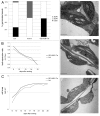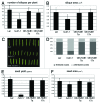Is HUB1 a hub for plant fitness?
- PMID: 23073007
- PMCID: PMC3578887
- DOI: 10.4161/psb.22326
Is HUB1 a hub for plant fitness?
Abstract
Recently, we have identified circadian clock genes as targets of Histone Monoubiquitination1 (HUB1) in Arabidopsis from a transcriptome comparison between the hub1-1 mutant and HUB1 overexpression lines. HUB1 affected the amplitudes of the circadian clock gene expression profiles in the hub1-1 mutant that coincided with reduced monoubiquitination of histone H2B at their coding regions. Here we showed that parameters for plant fitness are altered in HUB1 mutant and overexpression lines, suggesting that the histone H2B monoubiquitination status affects plant fitness.
Keywords: Arabidopsis thaliana; H2B monoubiquitination; chloroplast development; germination; seed parameters; yield.
Figures


References
-
- Himanen K, Woloszynska M, Boccardi TM, De Groeve S, Nelissen H, Bruno L, et al. Histone H2B monoubiquitination is required to reach maximal transcript levels of circadian clock genes in Arabidopsis. Plant J 2012; July 5. doi: 10.1111/j.1365-313X.2012.05071.x. [Epub ahead of print] PMID:22762858. - PubMed
Publication types
MeSH terms
Substances
LinkOut - more resources
Full Text Sources
Molecular Biology Databases
